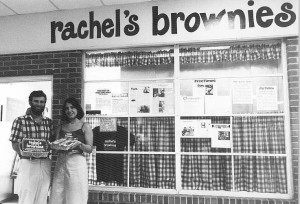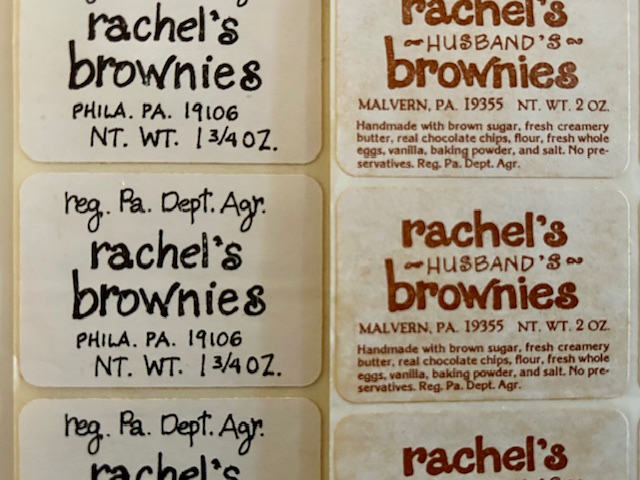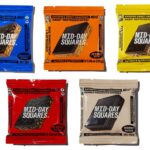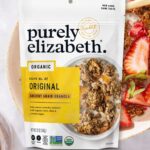Mastering the Art of Logo Design for Your 2024 Food Product
In the ever-evolving world of food products, a logo serves as the face of your brand, communicating your values, essence, and promise to consumers.
In 1975, when my wife sold her first brownie to a local specialty food store, she created a logo for Rachel’s Brownies in her handwriting. It was a homemade brownie, so the font others used was out of the question.
The logo was her actual handwriting.

The hand-lettered homemade label remained with the brand for the business’s life. She wanted to convey the opposite of something mass-produced. Other brownies sold in retail stores were mass produced and used conventional design, fonts, and imagery.
Her first labels were black and white – eventually we made the labels in brown for chocolate and a buterscotch color for the Rachel’s Husband’s Butterscotch brownie.
As I have spent a lifetime building brands, I thought I’d explore the seven critical design considerations I have used for crafting a logo that captures the essence of your food product and resonates with consumers in 2024.
1. Simplicity is the Ultimate Sophistication:
Legendary designer Paul Rand once said, “Design is so simple; that’s why it is so complicated.” In the world of logo design, simplicity reigns supreme. A clutter-free, easily recognizable logo will likely leave a lasting impression.
Who is Paul Rand, and what is he known for designing?
Paul Rand (born Peretz Rosenbaum; August 15, 1914 – November 26, 1996) was an American art director and graphic designer best known for his corporate logo designs, including the logos for IBM, UPS, Enron, Morningstar, Inc., Westinghouse, ABC, and NeXT.
Think of the iconic Apple logo – a sleek, minimalist apple with a bite taken out. This simplicity allows instant recognition and has become synonymous with quality and innovation.
Apply this principle to your food product by distilling its essence into a simple yet powerful visual. Consider McDonald’s golden arches – a minimalist representation that has become one of the most recognizable logos globally, conveying the brand’s accessibility and warmth.
2. Color Psychology:
Color plays a pivotal role in shaping consumer perceptions and emotions. Each color elicits specific feelings and associations. For a food product, the choice of colors should evoke the desired emotions and connect with the target audience.
Take Coca-Cola’s logo as an example. The bold use of red conveys energy, passion, and excitement. In food, red can stimulate appetite and create a sense of indulgence. When selecting colors for your food product logo, consider the emotional response you want to evoke and choose a palette that aligns with your brand identity.
3. Versatility Across Platforms:
In the digital age, your logo must be adaptable to various platforms and devices, from packaging to social media icons. A versatile logo maintains its integrity and impact regardless of size or format.
Look at Nike’s swoosh – a timeless symbol that translates seamlessly across products, advertising, and digital platforms. Apply this versatility to your food product logo to ensure it remains impactful on labels, websites, and social media profiles.
4. Reflecting Brand Personality:
Your logo should encapsulate the personality of your food product. Whether it’s the organic and sustainable vibes of Whole Foods’ logo or the fun and quirky personality of Ben & Jerry’s, your logo should align with your brand’s values and resonate with your target audience.
Consider the playful nature of M&M’s logo. The vibrant colors and playful lettering reflect the brand’s fun and enjoyable confectionery offerings. Infuse your food product logo with personality to create a connection with consumers beyond the plate.
5. Timelessness for Longevity:
A logo is a “Versatility Across Platforms” that refers to the ability of a software, application, or system to function smoothly and efficiently on different devices and operating systems.
The software can adapt to different environments without compromising its performance or functionality. This feature is highly desirable as it allows users to access and use the software on various devices and platforms. “Versatility Across Platforms” refers to the ability of a software, application, or system to function smoothly and efficiently on different devices and operating systems. The software can adapt to different environments without compromising its performance or functionality.
This feature is highly desirable as it allows users to access and use the software on various devices and platforms—an investment in your brand’s future. Aim for a design that transcends trends and stands the test of time. Analyze the enduring appeal of logos like Pepsi or Nestlé. These brands have evolved, but their logos have retained a timeless quality.
For your food product, think about how the logo will look not just in 2024 but in 2030 and beyond. Avoid overly trendy elements that may quickly become outdated. The goal is to create a logo that can grow with your brand.
6. Cultural Sensitivity and Global Appeal:
In an interconnected world, a logo should be culturally sensitive and resonate with a diverse audience. Consider the global appeal of logos like Starbucks, with its universally recognizable mermaid icon. The design incorporates elements that appeal to various cultures, making it a global symbol of quality coffee.
When crafting your food product logo, consider cultural nuances and symbols. Ensure that your logo is inclusive and doesn’t unintentionally alienate any demographic.
7. Storytelling Through Symbolism:
A great logo tells a story, offering a glimpse into the narrative of your food product. Analyze the KFC logo – the Colonel’s silhouette evokes a sense of tradition and authenticity, telling the story of the brand’s heritage.
Think about the story you want to tell through your food product. Whether it’s the journey of sourcing local ingredients or a family recipe passed down through generations, infuse symbolism into your logo to create a compelling narrative that resonates with consumers.
Crafting a logo for your 2024 food product requires a thoughtful blend of simplicity, color psychology, versatility, personality, timelessness, cultural sensitivity, and storytelling.
By drawing inspiration from the world’s most excellent logo designers and their iconic creations, you can create a symbol that not only represents your food product but becomes an enduring emblem in the hearts and minds of consumers.
Remember, a great logo is not just a visual identity – it’s a story waiting to be told.

Connect with Jeff at The Marketing Sage Consultancy. Interested in setting up a call with me? Use my calendly to schedule a time to talk. The call is free, and we can discuss your brand and marketing needs. If you want to learn more about my new offering, The Trusted Advisor Board, you can click here to learn the details. Feel free to email me at jeffslater@themarketing sage.com or text 919 720 0995. Thanks for your interest in working with The Marketing Sage Consultancy.




